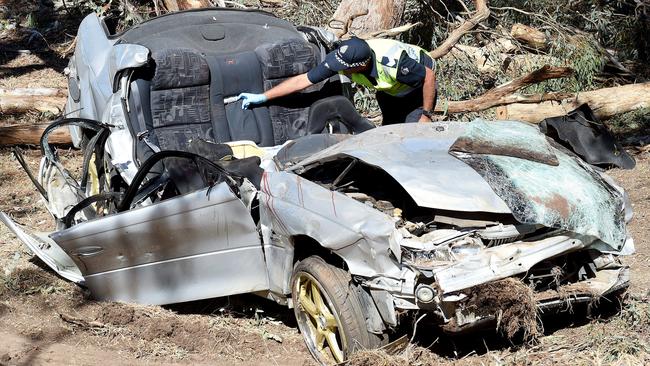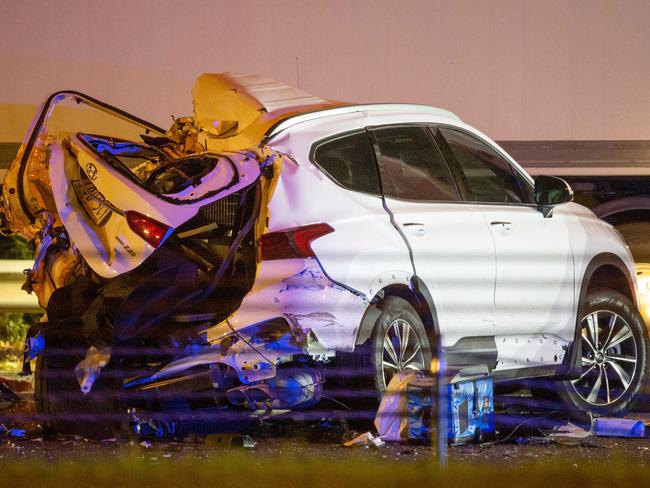Shocking truth behind road trauma statistics
A spiralling problem in Victoria is causing more road trauma across the state, and the top traffic cop says the findings are “alarming”.

Police & Courts
Don't miss out on the headlines from Police & Courts. Followed categories will be added to My News.
One in eight people injured in road crashes had taken illegal drugs such as ice before ending up in Melbourne’s major trauma centres, a shock new study has revealed.
Spiralling rates of ice use are fuelling Victoria’s drug driving injury toll, with doctors detecting methamphetamine in 77 per cent of those who used illicit substances before being in a crash.
The scourge of drug use has become so prevalent the year-long study in the Royal Melbourne and Alfred hospitals uncovered drug use by pedestrians and cyclists before they were struck by vehicles.
Victoria’s top traffic police officer, Assistant Commissioner Libby Murphy, has labelled results of the RMH-led study as “alarming”, saying they back up the experiences of officers undertaking roadside testing.
After gaining unprecedented ethical approval to drug test all emergency patients involved in vehicle crashes — not just drivers already suspected as having used — the Melbourne researchers built the most comprehensive picture of illicit drug use and motor vehicle trauma.
While the study revealed far higher rates of drug use than previously reported, RMH Professor of emergency medicine George Braitberg said nobody who dealt with the carnage inside Victoria’s trauma centres each day would be surprised.
“These are people that are causing the most harm to themselves, they are sicker patients,” Prof Braitberg said.
“Those that were testing positive, more than 50 per cent of them were involved in single vehicle accidents. That is much more than the non-illicit drug-taking population.
“They drove into stationary objects, they couldn’t protect themselves and so they did more damage to themselves in the process.
“They were younger, they were more likely to be coming in the early hours of the morning and they were more likely to be sicker.
“More of them were presenting in some form of unconscious state or with a higher triage score to indicate they were of the sicker spectrum.”
The latest findings come after related RMH research last year revealed 40 per cent of people acting violently and attacking staff in emergency departments had taken drugs — the vast majority being ice.
The latest study of more than 1300 patients treated at the RMH and Alfred trauma centres between August 2018 and August 2019 revealed 13 per cent of crash victims tested positive to at least one illicit substance.
Of the 173 patients to have taken drugs, 133 — or 77 per cent — were positive for methamphetamine. One in five had more than one drug detected.

Among the injured who had been using drugs, 99 were drivers and 28 were passengers, 32 were motorcyclists, nine were pedestrians, four were cyclists and the status of one patient was unknown.
The research also showed those who had drugs in their system received worse injuries than those without. They had higher rates of needing intensive care or requiring immediate surgery, and more than double the chance of ending up back in hospital within 28 days.
Led by RMH emergency doctors and published in the journal Drug and Alcohol Review, the study found significantly higher rates of drug use than previous research published in 2015, which detected drugs in 5 per cent of crash victims, and 2020, which detected drugs in 9 per cent.
Backed by the findings, Melbourne emergency doctors are now calling for the SPIT-T saliva drug test to be used in EDs across Australia so they can know immediately if a patient has been using drugs, which may impact their treatment or allow them referral for counselling and other help.
Prof Braitberg said the increasing use of ice was driving the trend, demanding advertising campaigns to target younger people and make them realise the danger they face.
“Methamphetamines take away your inhibitions, they speed up your brain so it doesn’t think in a co-ordinated way, it thinks in a chaotic way,” Prof Braitberg said.
“Putting someone who has got disordered thought behind the wheel of a car is a lot of badness.
“It is really erratic, uncoordinated, unstructured thinking and you just know that is not the right sort of thinking you want behind the wheel.”
Assistant Commissioner Libby Murphy said it was unfortunate that the RMH and Alfred figures came as no surprise to her.
In 2021, 9968 motorists were positive for drugs and 502 refused to be tested, out of 150,397 samples taken.
There were 5898 fails for meth.
“It’s completely alarming,” Ms Murphy said.
Another major element of concern, she said, was the level of “poly-use”, where drivers come up with traces of more than one substance.
The figures showed 1574 positive for meth and THC, 159 for meth and MDMA and 58 for all three.
Ms Murphy said drugs had a range of potentially dangerous effects, including distorting vision, slowing reaction times, impair distance judgment and encouraging risk-taking.
“Crap choices” to drive anyway left the Alfred to deal with the damage she said.
“They think their reason to drive is more important than the safety of others,” Ms Murphy said.
The licences of drug-drivers can now be suspended on the spot and they receive $645 and six-month suspensions.


